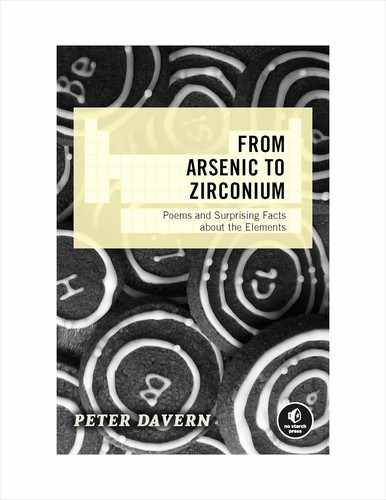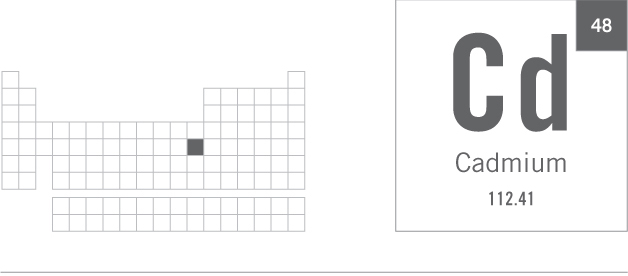CADMIUM, Cd
ITAI-ITAI!
kad-mee-uhm
Oh cadmium builds toxic’lly in kidneys, by and by,
GROUP 12 TRANSITION METAL
Cadmium suffers from a rather poor public image but with good reason. Its similarity to zinc means it’s readily absorbed by the human body. Upon absorption, most of it quickly binds to the metallothionein enzyme and is transported to the kidneys to be excreted in urine. Unfortunately, cadmium binds so strongly to the enzyme that it can gradually build to levels that significantly impair kidney function, sometimes leading to kidney failure.
By tainting rice it caused such pain in bones—Itai-Itai!
Exposure to cadmium also contributes to a disease first seen in Japan in the early to mid-1900s. The disease became known by its Japanese name Itai-Itai (meaning ouch-ouch! or it hurts, it hurts!). Those afflicted had eaten rice containing elevated levels of cadmium. The rice had been grown on land irrigated with water polluted by waste from a local mine. This, coupled with low levels of dietary vitamin D, led to symptoms of severe pains and weakness in bones and joints.
In fissile cores it curbs so well,
[curb: verb — to apply a check or control on something]
Cadmium is useful, despite its toxicity. For example, its ability to capture neutrons has prompted its use in the control rods in some nuclear reactor cores. When the rods are lowered farther into the core, they absorb neutrons produced from the radioactive decay of the fissile fuel (for example, uranium). This regulates these neutrons’ ability to promote the nuclear chain reaction that produces the energy. (See “Zirconium, Zr” on page 117 for more on fissile fuels and nuclear fission, and see “Uranium, U” on page 267 for a bit about nuclear chain reactions.)
Its sulfide help’d weave Monet’s spell.
Cadmium yellow (cadmium sulfide, CdS), because of its vibrant yellow-orange tones, was one of a handful of pigments used by the impressionist artist Claude Monet (1840–1926) to create his magical masterpieces.
nigh-cads
Why don’t you dump your NiCads with more care . . . oh why, oh why?!
Cadmium is perhaps best known for being one-half of the nickel-cadmium combination in rechargeable NiCad batteries. Although still quite popular, NiCad batteries are gradually being replaced by lighter and more powerful alternatives, such as nickel-metal hydride (NiMH) and lithium-ion batteries.
The future prospects for NiCad batteries are hindered by cadmium’s toxicity. Because cadmium eventually leaches from them and contaminates the environment, spent NiCad batteries should be brought to designated collection points for recycling rather than just dumping them in a landfill (with your normal household trash). Don’t say you weren’t told!


